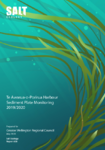Te Awarua-o-Porirua Harbour Sediment Plate Monitoring 2020 Survey
Search in document library
The steady increase in sediment at the Onepoto intertidal sites is attributable largely to the deposition of coarse sediment on the Porirua Stream delta and the movement of sand across the tidally swept site near the Harbour entrance. During 2019, sediment deposition increased by an average of 4.6 mm and mean sediment mud content doubled across all Pāuatahanui intertidal sites. Results also showed an increase in subtidal sedimentation of 7 mm/year in the Pāuatahanui Inlet and net subtidal erosion of 2.5 mm/year in the Onepoto Inlet over the past seven years. Erosion, however, is largely an artefact of the baseline monitoring commencing shortly after a significant deposition event in the Onepoto Inlet in 2013. Since then, there has been an average increase in subtidal mud content of 66% in the Pāuatahanui Inlet, and 69% in the Onepoto Inlet. Mud content was highest in deeper settlement basin areas, with four of the five muddiest subtidal sites in the harbour located in Pāuatahanui. Throughout the Harbour, soft mud has extended shoreward by between 10 m and 305 m, with a corresponding large increase in the shallow subtidal area covered by mud-dominated sediments. Changes may be associated with episodic inputs of sediment from catchment sources. Recent rates of deposition greatly exceed the recommended ANZECC Default Guideline Value of 2 mm/year, indicating an increased likelihood of significant environmental damage.
Reference: Stevens LM, Forrest BM 2020. Te Awarua-o-Porirua Harbour Sediment Plate Monitoring 2019/2020. Salt Ecology Report 038, prepared for Greater Wellington Regional Council, May 2020. 20p.
Authors: Leigh Stevens and Barrie Forrest. Salt Ecology
